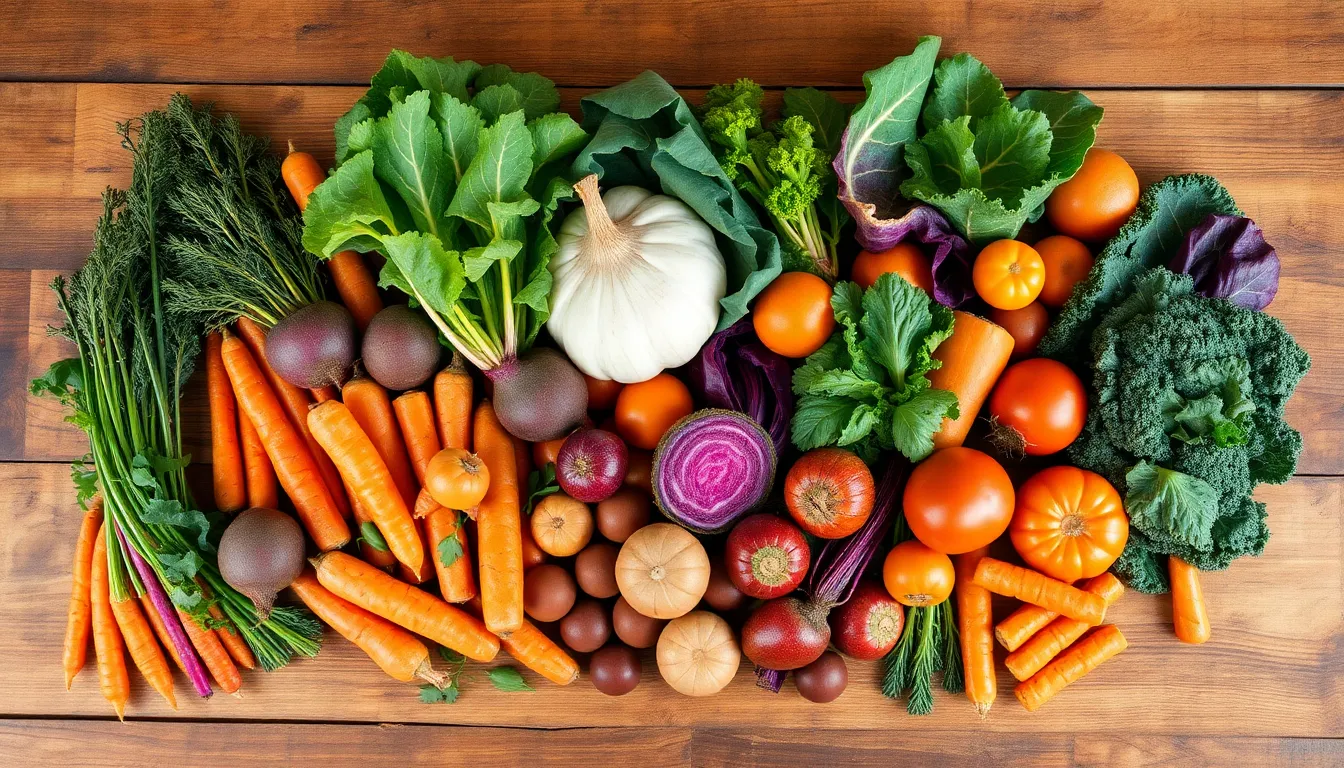Table of Contents
ToggleAs the temperature drops and snowflakes start to dance, winter brings more than just cozy sweaters and hot cocoa. It’s a season that invites culinary creativity and indulgence, transforming kitchens into warm havens of flavor. This year, food enthusiasts are in for a treat as winter food trends take center stage, promising to warm hearts and fill bellies.
From hearty dishes that hug you from the inside to innovative twists on traditional favorites, winter food trends are all about comfort with a dash of excitement. Think spicy soups that chase away the chill and desserts that make you forget about your New Year’s resolutions. So grab your mittens and prepare for a delicious journey through the most mouthwatering winter trends that’ll have everyone talking (and maybe even melting the ice on their hearts).
Overview of Winter Food Trends
Winter food trends focus on warmth, comfort, and creativity in the kitchen. Cozy ingredients take center stage, featuring root vegetables, hearty grains, and rich broths. Seasonal spices like cinnamon, nutmeg, and cloves elevate flavors in both sweet and savory dishes.
Many culinary enthusiasts embrace the use of warming herbs such as ginger, which add depth to dishes while also offering health benefits. Fermented foods also gain popularity during winter, as they provide probiotics that support immune health.
Plant-based meals become more prevalent, as individuals seek nutritious, hearty options. Dishes like lentil stews and vegetable curries not only showcase the abundance of winter produce but also align with dietary preferences. Comfort foods that include stews and casseroles offer satisfying, filling meals.
Gourmet hot chocolates and spiced coffees gain traction, creating cozy beverage options for cold days. These drinks often incorporate unique twists, such as flavored syrups and artisanal toppings. Gourmet indulgence also reflects a shift towards elevated home dining experiences, with consumers investing in quality ingredients.
Moreover, presentation matters, as food styling becomes a vital component of winter dining. Plates adorned with vibrant colors stand out, even in the colder months. Seasonal ingredients inspire visually appealing arrangements, appealing to both taste and aesthetics.
Overall, winter trends emphasize warmth across various culinary categories, inviting exploration and creativity in the kitchen. From hearty meals to comforting drinks, winter provides an array of opportunities to indulge and enjoy.
Popular Ingredients for Winter

Winter inspires the use of specific ingredients that elevate seasonal dishes. Root vegetables and hearty greens stand out this time of year, each offering distinct flavors and nutritional benefits.
Root Vegetables
Root vegetables dominate winter menus due to their versatility and heartiness. Carrots, parsnips, and sweet potatoes provide natural sweetness, making them perfect for roasting or mashing. Turnips and beets add earthy flavors to soups and salads. These ingredients retain their nutrients during the cold months, ensuring wholesome meals that satisfy. Particularly, roasting enhances their natural sugars while yielding a comforting texture. Chefs often pair root vegetables with warming spices, amplifying their flavor profiles and creating comforting dishes that evoke seasonal nostalgia.
Hearty Greens
Hearty greens thrive in winter, contributing robust flavors and essential vitamins. Kale, Swiss chard, and collard greens flourish in the colder months, often used in soups, stews, and stir-fries. These greens hold up well during cooking, maintaining their nutrients and texture. Nutritional benefits include high fiber and essential minerals, promoting overall health during colder seasons. Combining hearty greens with citrus adds brightness, balancing flavors and enhancing dishes. Utilizing these greens in winter recipes ensures meals are both nutritious and satisfying, making them essential for any winter menu.
Comfort Foods Making a Comeback
Winter heralds significant nostalgia for comfort foods, leading many to revisit traditional favorites. Creamy macaroni and cheese remains a staple, often enhanced with gourmet cheeses or topped with crispy breadcrumbs. Hearty stews, brimming with root vegetables and tender meats, bring warmth and satisfaction to cold evenings.
Savory casseroles offer convenience and flavor. Cheesy broccoli and rice dishes emerge, appealing to families seeking ease without sacrificing taste. New methods for preparation enhance these classics—inclusive of slow-cooked variations and instant pot recipes that save time while retaining flavor integrity.
Soups continue to reign during winter months. Spicy lentil soup garners attention, providing both warmth and a nutritious profile. Tomato basil soup paired with grilled cheese sandwich creates a beloved duo that warms both the body and soul.
Desserts rank high on the comfort scale as well. Classic bread puddings showcase seasonal spices like nutmeg and cinnamon, while decadent hot chocolate variations invite indulgence. Many opt for flavored marshmallows, enhancing the cozy beverage experience.
Fermented foods also regain popularity, leading to the revival of gut-healthy dishes like kimchi fried rice. This dish combines comfort with nutrition, bringing fresh flavors alongside traditional warmth.
Classic baked goods make a reappearance in kitchens. Freshly baked pies, especially apple and pecan, remind diners of home cooking and shared memories. Grown-ups often enjoy adult versions of comfort treats, with bourbon-infused pecan pie surfacing as a seasonal favorite.
As winter progresses, these comfort foods resonate, bridging the gap between tradition and modern culinary creativity. Seasonal favorites reinforce the connection to warmth, nostalgia, and satisfaction, drawing everyone closer during cozy meals.
Global Influences on Winter Cuisine
Global cuisine influences create exciting winter dishes filled with warmth and comfort. Many chefs incorporate flavors and techniques from around the world into their seasonal menus.
Asian-inspired Dishes
Asian-inspired dishes shine during winter months, offering delectable warmth and vibrant flavors. Hearty broths featuring ramen and pho provide comfort, often infused with aromatic herbs like lemongrass and basil. Spicy curries using coconut milk, ginger, and garlic become favorites for those seeking heat and richness in each bite. Fermented ingredients like kimchi and miso not only enhance flavor profiles but also contribute to gut health during colder months. The use of warming spices such as turmeric and chili increases popularity, drawing attention to their anti-inflammatory properties.
Mediterranean Flavors
Mediterranean flavors capture attention in winter culinary trends, prioritizing healthy, aromatic ingredients. Rich, hearty dishes like Mediterranean stews combine chickpeas, olives, and seasonal vegetables for satisfaction and nutrition. Citrus fruits, especially oranges and lemons, brighten seasonal meals, balancing earthy flavors with refreshing zest. Olive oil becomes a staple, enhancing both taste and nutritional value. Herbes de Provence, with its blend of herbs, adds depth to roasted dishes and enhances comfort food. The focus on seasonal produce reflects a commitment to freshness, elevating the winter dining experience.
Sustainable Practices in Winter Cooking
Sustainable practices in winter cooking focus on reducing environmental impact while enjoying seasonal ingredients. Utilizing local produce ensures freshness and lowers carbon footprints associated with transportation. Many chefs prioritize organic options, minimizing pesticide usage and promoting healthier ecosystems.
Incorporating root vegetables from nearby farms represents a practical approach to seasonal eating. Carrots, parsnips, and sweet potatoes deliver nutrients while supporting local agriculture. This choice also aligns with the trend towards plant-based meals, which often emphasize sustainability.
Cooking with leftovers plays a key role in minimizing waste and maximizing flavors. Transforming yesterday’s hearty stew into a pot pie or using roasted vegetables in grain bowls proves efficient and creative. Such practices reflect a commitment to resourcefulness and environmental consciousness.
Supporting community-supported agriculture programs enhances this sustainable approach. Signing up for weekly produce shares connects consumers with local farmers and provides fresh, seasonal ingredients. By actively participating in these programs, individuals contribute to farm sustainability and community health.
Adopting plant-based ingredients further promotes sustainability in winter meals. Dishes like lentil stews, vegetable curries, and chickpea-based casseroles become more prevalent as people seek nutritious, environmentally friendly options. These meals not only comfort but also benefit the planet.
Exploring fermentation techniques aligns with sustainable cooking strategies. Fermented foods, such as sauerkraut and kimchi, enhance flavors while supporting gut health. This method reduces food waste by preserving seasonal produce and maximizing their culinary potential.
Emphasizing sustainable practices in winter cooking creates a rewarding culinary experience. Prioritizing local, organic, and plant-based options fosters a connection between food choices and environmental impact. Engaging with seasonal ingredients not only warms hearts and bellies but also contributes to a healthier planet.
Winter food trends offer a wonderful opportunity to embrace warmth and creativity in the kitchen. As the season unfolds, it invites exploration of hearty ingredients and comforting recipes that resonate with nostalgia. The focus on plant-based meals and sustainable practices not only enhances flavor but also supports a healthier planet.
Chefs and home cooks alike can find inspiration in global influences and innovative techniques that transform traditional dishes into modern delights. By prioritizing local and seasonal ingredients, winter cooking becomes a celebration of both taste and sustainability. This season promises to be a delicious journey that warms both the heart and soul.







